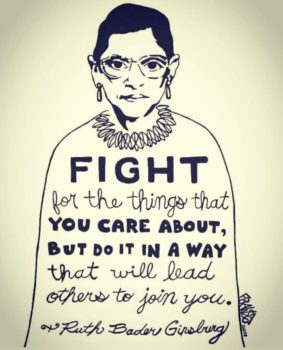 Supreme Court Justice Ruth Bader Ginsburg, died Sept. 18 at the age of 87, due to complications from pancreatic cancer. Ginsburg was known not only for her work as a Supreme Court justice, but also as a pioneer of women’s rights and an icon of justice for many. She is survived by her children, Jane C. Ginsburg and James S. Ginsburg, and several grandchildren. Her husband, Martin D. Ginsburg, died of cancer in 2010.
Supreme Court Justice Ruth Bader Ginsburg, died Sept. 18 at the age of 87, due to complications from pancreatic cancer. Ginsburg was known not only for her work as a Supreme Court justice, but also as a pioneer of women’s rights and an icon of justice for many. She is survived by her children, Jane C. Ginsburg and James S. Ginsburg, and several grandchildren. Her husband, Martin D. Ginsburg, died of cancer in 2010.
Ginsburg was born March 15, 1933, in Brooklyn, New York to Nathan and Celia Bader and grew up in a low income neighborhood of Brooklyn. In her youth, Ginsburg excelled at her studies at James Madison High School and went on to attend Cornell University, earning a bachelor’s degree in government and finishing first in her class. Ginsburg graduated from Cornell in 1954, that same year, she married law student Martin D. Ginsburg. Ginsburg gave birth to her first child, Jane, later that same year shortly after her husband was drafted into the military.
Two years later, Martin was discharged, and Ginsburg began attending Harvard. She found herself in a male dominated atmosphere, but continued to excel academically and became the first female member of the Harvard Law Review. While attending Harvard, Martin accepted a job at a New York law firm. To follow her husband, Ginsburg transferred to Columbia University where she would graduate first in her class in 1959.
Before joining the Supreme Court, Ginsburg continued to face gender discrimination as she struggled to find employment. She eventually went on to work as a clerk for the U.S. District Judge Edmund L. Palmieri from 1959 to 1961, a professor at Rutgers University Law School from 1963 to 1972, and a professor at Columbia University from 1972 to 1980 where she became the first tenured female professor. Ginsburg also served as the director of the Women’s Rights Project of the American Civil Liberties Union in the 70s, arguing on gender equality cases in the Supreme Court.
In 1980 President Jimmy Carter appointed Ginsburg to the U.S. Court of Appeals for the District of Columbia. She served there until she was appointed to the U.S. Supreme Court in 1993 by President Bill Clinton to fill the seat left by Justice Byron White.
On the Supreme Court, Ginsburg favored moderation and restraint. She was considered part of the Supreme Court’s moderate-liberal bloc presenting a strong voice in favor of gender equality, the rights of workers and the separation of church and state. In 1999, Ginsburg won the American Bar Association’s Thurgood Marshall Award for her contributions to gender equality and civil rights.
In 2016, Ginsburg released her memoir “My Own Words” with writings that date as far back as her junior high years. In 2018, Ginsburg made an appearance at the Sundance Film Festival to accompany the premiere of the documentary “RBG,” a documentary on Ginsburg herself.
Ginsburg died at her home in Washington, D.C after 27 years of service to the Supreme Court. Ginsburg laid in state in the Capitol on Sept. 25. She will be the first woman and second Supreme Court Justice to have this honor.
Upon her death, Chief Justice John Roberts stated, “Our nation has lost a jurist of historic stature. We at the Supreme Court have lost a cherished colleague. Today we mourn, but with confidence that future generations will remember Ruth Bader Ginsburg as we knew her — a tireless and resolute champion of justice.”





Comments